HTC FORE Smartphone User Manual Foreseer Generic Manual English indb
HTC Corporation Smartphone Foreseer Generic Manual English indb
HTC >
Contents
- 1. Users Manual Part I
- 2. Users Manual Part II
Users Manual Part I

Smart
User Manual
2
Congratulations on the purchase of your new Windows Mobile™
Smartphone
!
Please Read Before Proceeding.
THIS DEVICE IS NOT CHARGED WHEN YOU TAKE IT OUT OF THE BOX.
DO NOT REMOVE THE BATTERY PACK WHEN THE DEVICE IS CHARGING.
YOUR WARRANTY IS INVALIDATED IF YOU OPEN OR TAMPER WITH THE DEVICE’S OUTER
CASING.
PRIVACY RESTRICTIONS
Some countries require full disclosure of recorded telephone conversations, and stipulate
that you must inform the person with whom you are speaking that the conversation is being
recorded. Always obey the relevant laws and regulations of your country when using the
recording feature of your phone.
COPYRIGHT INFORMATION
Microsoft, MS-DOS, Windows, Windows NT, Windows Server, Windows Mobile, ActiveSync,
Excel, Internet Explorer, MSN, Outlook, PowerPoint, and Word are either registered trademarks
or trademarks of Microsoft Corporation in the United States and/or other countries.
3
Important Health Information and Safety Precautions
When using this product, the safety precautions below must be taken to
avoid possible legal liabilities and damages.
Retain and follow all product safety and operating instructions. Observe all
warnings in the operating instructions on the product.
To reduce the risk of bodily injury, electric shock, fire and damage to the
equipment, observe the following precautions.
ELECTRICAL SAFETY
This product is intended for use when supplied with power from the
designated battery or power supply unit. Other usage may be dangerous
and will invalidate any approval given to this product.
SAFETY PRECAUTIONS FOR PROPER GROUNDING INSTALLATION
CAUTION – Improper connection of associated equipment-grounding can
result in a risk of electric shock.
This product equipped with an ActiveSync Cable for connecting with desk-
top or notebook computer. Be sure your computer is properly grounded
(earthed) before connecting this product to the computer. The desk-top
or notebook computer is equipped with a power supply cord having an
equipment grounding conductor and a grounding plug. The plug must
be plugged into an appropriate outlet which is properly installed and
grounded in accordance with all local codes and ordinances.
SAFETY PRECAUTIONS FOR POWER SUPPLY UNIT
•Use the correct external power source
A product should be operated only from the type of power source
indicated on the electrical ratings label. If you are not sure of the type
of power source required, consult your authorized service provider or
local power company. For a product that operates from battery power
or other sources, refer to the operating instructions that are included
with the product.
•Handle battery packs carefully
This product contains a Li-ion Polymer battery. There is a risk of fire
and burns if the battery pack is handled improperly. Do not attempt to
open or service the battery pack. Do not disassemble, crush, puncture,
short external contacts or circuits, dispose of in fire or water, or expose
a battery pack to temperatures higher than 60˚C (140˚F).

4
WARNING! Danger of explosion if battery is incorrectly replaced. To
reduce risk of fire or burns, do not disassemble, crush,
puncture, short external contacts, expose to temperature
above 60oC (140oF), or dispose of in fire or water. Replace only
with specified batteries. Recycle or dispose of used batteries
according to the local regulations or reference guide supplied
with your product.
SAFETY PRECAUTIONS FOR DIRECT SUNLIGHT
Keep this product away from excessive moisture and extreme temperatures.
Do not leave the product or its battery inside a vehicle or in places where
the temperature may exceed 60°C (140°F), such as on a car dashboard,
window sill, or behind a glass that is exposed to direct sunlight or strong
ultraviolet light for extended periods of time. This may damage the product,
overheat the battery, or pose a risk to the vehicle.
SAFETY PRECAUTIONS FOR ACOUSTIC PRESSURE
CAUTION –Permanent hearing loss may occur if earphones or headphones
are used and prolonged listening at high volume.
NOTE: For France, mobile headphones or earphones for this device
(Manufactured by Supplier Name:Merry, Model Numbers:
EMC220-001) has been tested to comply with the Sound
Pressure Level requirement laid down in NF EN 50332-1:2000
standard as required by French Article L. 5232-1.
5
SAFETY IN AIR CRAFTS
Due to the possible interference caused by this product to an aircraft’s
navigation system and its communications network, using this device’s
phone function on board an airplane is against the law in most countries. If
you want to use this device when on board an aircraft, remember to turn off
your phone by switching to Flight Mode.
ENVIRONMENT RESTRICTIONS
Do not use this product in gas stations, fuel depots, chemical plants or
where blasting operations are in progress, or in potentially explosive
atmospheres such as fuelling areas, fuel storehouses, below deck on
boats, chemical plants, fuel or chemical transfer or storage facilities, and
areas where the air contains chemicals or particles, such as grain, dust, or
metal powders. Please be aware that sparks in such areas could cause an
explosion or fire resulting in bodily injury or even death.
EXPLOSIVE ATMOSPHERES
When in any area with a potentially explosive atmosphere or where
flammable materials exist, the product should be turned off and the user
should obey all signs and instructions. Sparks in such areas could cause an
explosion or fire resulting in bodily injury or even death. Users are advised
not to use the equipment at refueling points such as service or gas stations,
and are reminded of the need to observe restrictions on the use of radio
equipment in fuel depots, chemical plants, or where blasting operations
are in progress. Areas with a potentially explosive atmosphere are often,
but not always, clearly marked. These include fueling areas, below deck on
boats, fuel or chemical transfer or storage facilities, and areas where the air
contains chemicals or particles, such as grain, dust, or metal powders.
ROAD SAFETY
Vehicle drivers in motion are not permitted to use telephony services with
handheld devices, except in the case of emergency. In some countries,
using hands-free devices as an alternative is allowed.
INTERFERENCE WITH MEDICAL EQUIPMENT FUNCTIONS
This product may cause medical equipment to malfunction. The use of this
device is forbidden in most hospitals and medical clinics.
6
NONIONIZING RADIATION
This product should be operated in the suggested normal condition only
to ensure the radiative performance and safety of the interference. As with
other mobile radio transmitting equipment, users are advised that for
satisfactory operation of the equipment and for the safety of personnel, it
is recommended that no part of the human body be allowed to come too
close to the antenna during operation of the equipment.
GENERAL PRECAUTIONS
• Heed service markings
Except as explained elsewhere in the Operating or Service
documentation, do not service any product yourself. Service needed
on components inside these compartments should be done by an
authorized service technician or provider.
• Damage requiring service
Unplug the product from the electrical outlet and refer servicing to
an authorized service technician or provider under the following
conditions:
•
Liquid has been spilled or an object has fallen into the product.
•
The product has been exposed to rain or water.
•
The product has been dropped or damaged.
•
There are noticeable signs of overheating.
•
The product does not operate normally when you follow the
operating instructions.
•
Avoid hot areas
The product should be placed away from heat sources such as
radiators, heat registers, stoves, or other products (including amplifiers)
that produce heat.
• Avoid wet areas
Never use the product in a wet location.
• Avoid pushing objects into product
Never push objects of any kind into cabinet slots or other openings
in the product. Slots and openings are provided for ventilation. These
openings must not be blocked or covered.
7
• Mounting Accessories
Do not use the product on an unstable table, cart, stand, tripod, or
bracket. Any mounting of the product should follow the manufacturer’s
instructions, and should use a mounting accessory recommended by
the manufacturer.
• Avoid unstable mounting
Do not place the product with an unstable base.
• Use product with approved equipment
This product should be used only with personal computers and options
identified as suitable for use with your equipment.
• Adjust the volume
Turn down the volume before using headphones or other audio
devices.
• Cleaning
Unplug the product from the wall outlet before cleaning. Do not use
liquid cleaners or aerosol cleaners. Use a damp cloth for cleaning, but
NEVER use water to clean the LCD screen.
8
Contents
Chapter 1 Getting Started 11
1.1 Getting to Know your Phone and its Accessories ...............12
1.2 Inserting the SIM Card and Micro SD Card ..........................18
1.3 The Home Screen ..................................................................19
1.4 Status Indicators and Program Icons ..................................20
1.5 Using the Start Menu ............................................................23
1.6 Using the Quick List ..............................................................24
1.7 Entering Information ............................................................24
1.8 Battery Information ..............................................................28
Chapter 2 Using Phone Features 29
2.1 Using the Phone ....................................................................30
2.2 Making a Voice Call ...............................................................31
2.3 Receiving a Voice Call ...........................................................34
2.4 In-Call Options ......................................................................34
2.5 Additional Dialing Information ...........................................36
Chapter 3 Synchronizing Information and
Setting Up E-mail Security 39
3.1 About ActiveSync ..................................................................40
3.2 Setting Up ActiveSync ..........................................................40
9
3.3 Synchronizing Information ..................................................43
3.4 Synchronizing via Bluetooth ...............................................48
3.5 Synchronizing Music, Video and Pictures ...........................49
3.6 Setting Up E-mail Security ...................................................50
Chapter 4 Managing Your Phone 53
4.1 Personalizing your Phone ....................................................54
4.2 Adding and Removing Programs ........................................59
4.3 Using Task Manager and Managing Memory .....................60
4.4 Managing and Backing Up Files ..........................................62
4.5 Protecting your Phone .........................................................64
4.6 Restarting your Phone .........................................................66
4.7 Resetting your Phone ...........................................................66
Chapter 5 Getting Connected 67
5.1 Connecting to the Internet ..................................................68
5.2 Using Internet Explorer Mobile ...........................................72
5.3 Using Internet Sharing .........................................................74
5.4 Using Comm Manager ..........................................................75
5.5 Using Bluetooth ....................................................................76
Chapter 6 Exchanging Messages and
Using Outlook 87
6.1 Using E-mail and Text Messages ..........................................88
6.2 Using MMS Messages ...........................................................96
10
6.3 Using Pocket MSN Messenger .......................................... 103
6.4 Using Calendar ................................................................... 105
6.5 Using Contacts .................................................................. 106
6.6 Using Tasks ......................................................................... 111
6.7 Using Voice Notes .............................................................. 112
Chapter 7 Experiencing Multimedia 115
7.1 Using Camera and Video Recorder ................................... 116
7.2 Using Pictures & Videos ..................................................... 126
7.3 Using Windows Media Player ............................................ 130
7.4 Using MIDlet Manager ....................................................... 138
Chapter 8 Using Other Applications 143
8.1 Using ClearVue Suite ......................................................... 144
8.2 Using Speed Dial ................................................................ 147
8.3 Watching TV ....................................................................... 150
Appendix 155
A.1 Regulatory Notices ............................................................ 156
A.2 PC Requirement to Run ActiveSync 4.x ............................ 160
A.3 Specifications ..................................................................... 161
Index 165

Chapter 1
Getting Started
1.1 Getting to Know your Phone
and its Accessories
1.2 Inserting the SIM Card
and Micro SD Card
1.3 The Home Screen
1.4 Status Indicators and Program Icons
1.5 Using the Start Menu
1.6 Using the Quick List
1.7 Entering Information
1.8 Battery Information
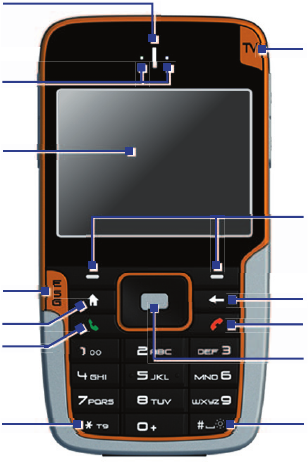
12
Getting started
1.1 Getting to Know your Phone and its
Accessories
2
5
4
69
7
1
10
11
12
3
8
13

Getting started 13
Item Function
1. Speaker
Listen to audio media or a phone call.
2. LED Indicators
Left LED: The bi-color indicator (green/red) notifies
you of the battery and network status of your phone
respectively.
Right LED: The blue indicator notifies you of Bluetooth
connectivity status.
For more information about LED Indicators, see the
table at the end of this section.
3. TV
Press to start watching TV.
4. Display Screen
5. Left/Right SOFT
KEY
Press to perform the command shown in the label
above the button.
6. ESG
Press to start the Penthera Viewer program.
7. HOME
Press to go to the Home Screen.
8. TALK
Press to dial a phone number, answer a call or use in-call
options, such as switching to another call or putting
a call on hold. Press and hold to activate/deactivate
speakerphone.
9. BACK
Press to go to the previous screen or backspace over
characters.
10.
END
Press to end a call.
Press and hold to lock the phone.
11. NAVIGATION
Control/ENTER
Use to scroll left, right, up or down. Press the center to
use as the ENTER button.
12.
Key
Press and switch to different input modes or press and
hold to choose an input mode or symbols from the list.
13.
Key
Press to add a space or press and hold to display a list of
symbols.
While watching TV, press to adjust the brightness of the
screen.
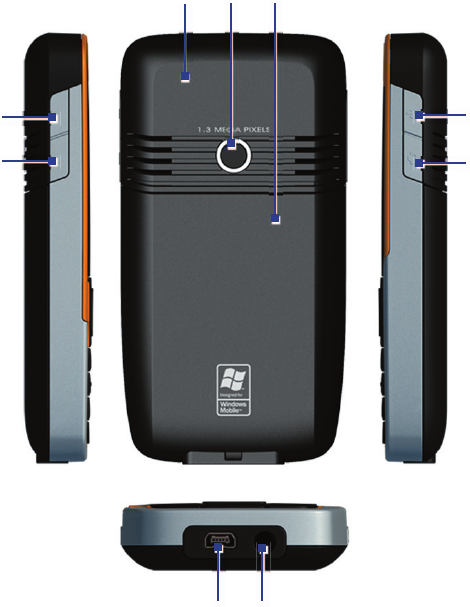
14
Getting started
14
18
19
21 22
17
15 16
20

Getting started 15
Item Function
14. Car Antenna
Connector
Allows you to attach your phone to the car antenna for
better network signal reception. Simply peel off the
rubber cap and connect the antenna jack. Replace the
rubber cap if unused.
15.
Camera Lens
1.3 Megapixels CMOS lens.
16. Back Cover
Remove to insert battery, SIM card and Micro SD card.
17. Volume Up/
Voice Notes
Press to increase the earpiece volume during a call.
Press and hold to start the Voice Notes recorder.
18. Volume Down/
Voice Notes
Press to decrease the earpiece volume during a call.
Press and hold to launch the Voice Tag feature.
19. POWER
Press to turn the phone on and off.
Or, press and quickly release to display the Quick List,
which allows you to change profiles, open Comm
Manager, enable key lock and device lock.
20. CAMERA
Press to launch the camera. If already running, press to
capture an image or start recording a video clip.
21.
Sync/Power
Connector
Use for synchronizing data or recharging the battery.
22. Earphone Jack
Connect the earphone to listen to audio media or use
the phone’s hands-free kit.

16
Getting started
LED indicator lights
Various colors that might display in the LED Indicator are summarized here.
Left LED Status
Solid green
Battery is fully charged.
Blank
Battery case is empty.
Solid amber
Battery is charging or the phone is using ActiveSync
to synchronize with a PC.
Flashing green
Connected to the network.
Flashing red
Battery very low (less than 4%).
Flashing amber
Battery temperature is hotter or colder than the
functional limits of 0 to 48 degrees Celsius (32 to
118 degrees Fahrenheit), and has stopped charging.
Amber/Green LED
off
Battery fault. The “Battery Fault” indicator (
) is
displayed. In this case, the flashing green LED can
be recovered by unplugging the AC adapter.
Right LED Status
Flashing blue
Bluetooth mode set to “On” or “Visible” mode.
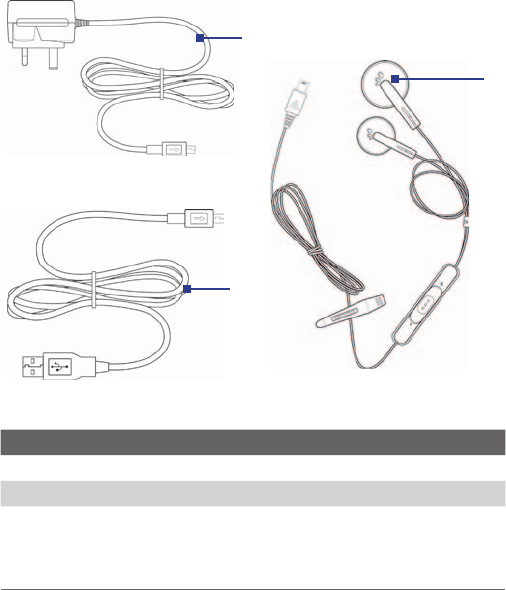
Getting started 17
Accessories
The following accessories are provided with the device:
1
2
3
Accessory Function
1. AC adapter
Recharge the phone battery.
2. USB cable
Connect your phone to a PC and synchronize data.
3.
Stereo
headset
Plug the headset into the sync connector on your
phone. It provides a volume control jog dial and a
Send/End button, which allows you to pick up and
hang up incoming and outgoing calls.
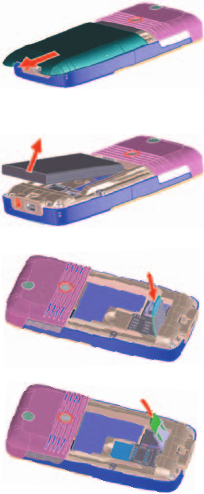
18
Getting started
1.2 Inserting the SIM Card and Micro SD Card
Your SIM (Subscriber Identity Module) card is given to you by your wireless service
provider and contains your basic subscriber information, such as your phone number
and your address book.
Before you begin, ensure that the phone is turned off.
1. Open the battery cover.
Hold the phone in one hand with the
keypad facing down in the palm of
your hand. With your other hand, press
down on the back cover and slide it
open.
2. Remove the battery.
Remove the battery by lifting it up
from the bottom end if you have
installed it.
3. Insert the SIM card.
Lift up the SIM card holder and insert
the SIM card into the holder with its
gold contacts facing down. When
completed, push the holder down.
4. Insert the Micro SD card (optional).
Lift up the Micro SD card holder and
insert your Micro SD card into the
holder with its gold contacts facing
down. When completed, push down
and lock the holder.
5. Replace the battery and the battery cover
.
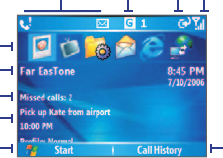
Getting started 19
1.3 The Home Screen
The Home screen displays important information, such as upcoming
appointments, status indicators, the current date, time, profile and icons of
programs that you have recently used. You can open a program directly by
selecting its icon and pressing ENTER.
•
To access the Home screen from anywhere, press HOME.
•
To customize the Home screen display, including the background,
click
Start > Settings > Home Screen
.
Home Screen
2
1
3
4
5 10
6 7 8 9
1.
Select a recently-used program and open it directly from the Home screen.
2.
Displays the name of your wireless service provider, date and time. Click to
open Comm Manager.
3.
Click to view the details of a missed call.
4.
Click to see the time of your next appointment.
5.
Click to display all program icons. Click to display all program icons.
6.
Displays notifi cations, such as missed calls or new messages.
7.
Displays the network or connectivity status.
8.
Displays the power status.
9.
Displays the network signal strength.
10.
Click to open Contacts, Call History or Messages.
Use the NAVIGATION CONTROL to scroll down the Home screen to see more
information, such as the current Profi le being used and number of new
messages that you have received. Click the information fi eld to change the
Profi le or open the Messages folder.
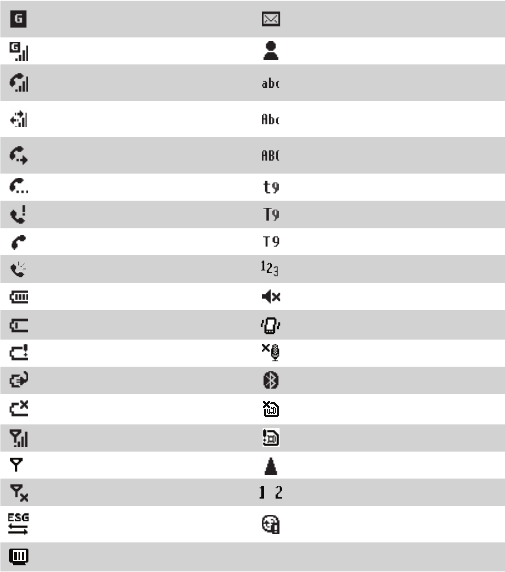
20
Getting started
1.4 Status Indicators and Program Icons
The following table lists common status indicators and their meanings.
GPRS available
New e-mail or text message
(SMS,
Short Message Service)
GPRS connected
New instant message
Voice call in progress
Multipress text input mode,
lowercase
Data call in progress
Multipress text input mode,
uppercase
Calls forwarded
Multipress text input mode, caps
lock
Call on hold
T9 text input mode, lowercase
Missed call
T9 text input mode, uppercase
Dialing while no SIM card installed
T9 text input mode, caps lock
Speakerphone on
Numeric input mode
Battery level
Ringer off
Low battery
Vibrate call alert
Very low battery
Microphone muted
Battery charging
Bluetooth
No battery or battery fault
No SIM card installed
Phone signal strength
SIM card with fault
Radio connected or no signal
Roaming
Radio off
/
Line 1/2
TV program schedule download
status
Sync error
TV signal strength
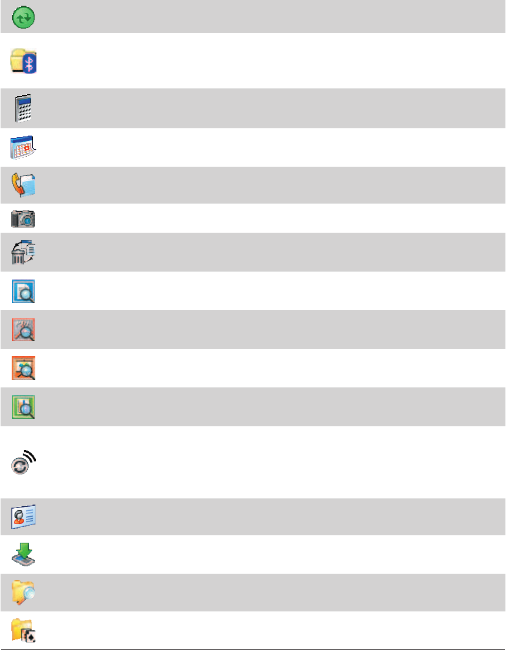
Getting started 21
The following table lists icons of the programs that are already installed on
your phone.
ActiveSync
Synchronizes information between your phone and a PC.
Bluetooth
Explorer
Searches for other Bluetooth devices that have file sharing
enabled and allows you to access their Bluetooth shared
folder.
Calculator
Performs basic arithmetic calculations, such as addition,
subtraction, multiplication and division.
Calendar
Keeps track of your appointments and creates meeting
requests.
Call
History
Keeps track of all phone calls made, received and missed.
Camera
Captures photos in various modes.
Clear
Storage
Clears the memory, restores the phone back to factory
default settings, then restarts the phone.
ClearVue
Document
Lets you view Word documents on your phone.
ClearVue
PDF
Lets you view PDF files on your phone.
ClearVue
PPT
Lets you view PowerPoint files on your phone.
ClearVue
Worksheet
Lets you view Excel worksheets on your phone.
Comm
Manager
Lets you easily enable or disable your phone, start or stop
synchronization with your computer, mute your phone,
enable or disable Bluetooth, stop data services and enable or
disable Direct Push.
Contacts
Keeps track of contact information.
Download
Agent
Provides information about the download status and the
downloaded content from the Internet.
File Explorer
Lets you organize and manage files on your phone.
Games
Lets you play one of two games: Bubble Breaker and Solitaire
come with your phone.
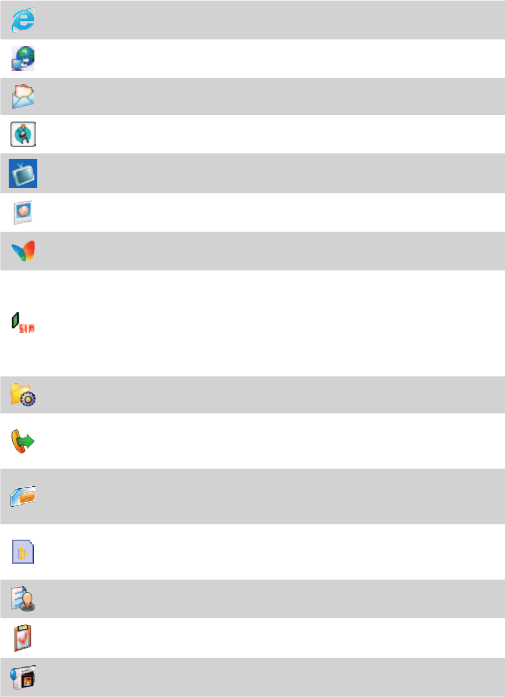
22
Getting started
Internet
Explorer
Allows you to browse Web and WAP sites, and to download
new programs and files from the Internet.
Internet
Sharing
Lets your phone act as an external modem for your computer
by using USB port or Bluetooth.
Messaging
Lets you send and receive e-mails and text messages.
MIDlet
Manager
Lets you download and install Java-based applications, such
as games and tools, on your phone.
Penthera
Viewer
Lets you watch TV on your phone.
Pictures &
Videos
Collects, organizes and sorts picture and video files in the My
Pictures folder on your phone or on a storage card.
Pocket
MSN
Lets you send and receive instant messages with your MSN
Messenger contacts.
SAP Settings
Enables Bluetooth Remote SIM access on your device. This
allows you to use a car kit phone that supports the SIM
Access Profile (SAP) to access the SIM card on your device
via Bluetooth and make or receive phone calls. You can also
download SIM contacts from your device onto the car kit
phone.
Settings
Personalize your phone to suit the way you use it.
Speed
Dial
Lets you create speed dial entries for dialling frequently-
called phone numbers or for opening frequently-accessed
programs.
SIM
Manager
Lets you manage the contacts that are stored on your SIM
card. You can also use this program to copy SIM contents to
Contacts on your phone.
STK (SIM
Tool Kit)
Service
Allows you to access information and other services offered
by your wireless service provider.
Task
Manager
Keeps track of your on-going programs.
Tasks
Keeps track of your tasks.
Video
Recorder
Captures video clips in various modes and duration.
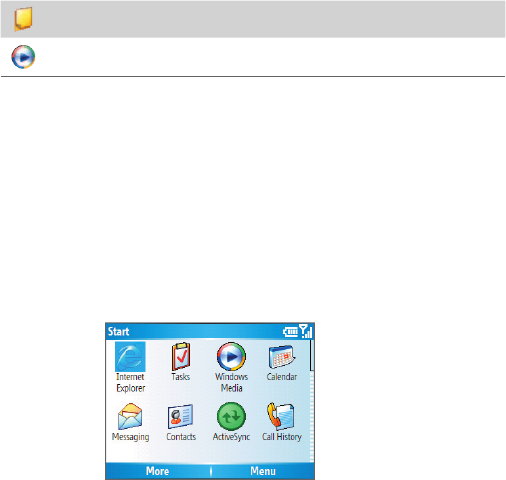
Getting started 23
Voice
Notes
Allows you to make short voice recordings.
Windows
Media
Lets you play back video and audio files.
1.5 Using the Start Menu
The Start menu is located at the bottom-left corner of the Home screen and
displays various program icons that are spread across one or more screens.
To see the available programs in the Start menu
•
On the Home screen, click
Start
.
•
To see more programs, click
More
.
Start menu
Your phone comes with several bundled programs that you can start using
immediately. You can also install additional programs from the included
Windows Mobile™ Getting Started Disc or from the Internet or purchase
mobile phone software from retail stores and install them to your phone.
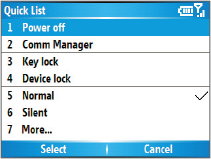
24
Getting started
1.6 Using the Quick List
The Quick List offers convenient access to a list of functions, such as
locking your phone or keypad and choosing a different profile. For more
information about profiles, see Chapter 4.
To access the Quick List
1.
Briefl y press (press and quickly release) the POWER button. Note that
pressing and holding the POWER button turns off the phone.
2.
Scroll through the list and select the desired item by clicking
Select
or
pressing the ENTER button.
3.
To exit the Quick List at any time, click
Cancel
.
Quick list
1.7 Entering Information
You can enter text and numbers by using the keypad. The phone supports
three input modes for entering text and numbers:
Multipress
,
T9
and
Numeric
. Multipress and T9 modes are used for entering text, and Numeric
mode is used for entering numbers.
When you select a field that requires you to enter text or numbers, the
phone automatically selects the appropriate input mode. The status
indicator on the top-right side of the display screen shows the input mode
that you are currently using.
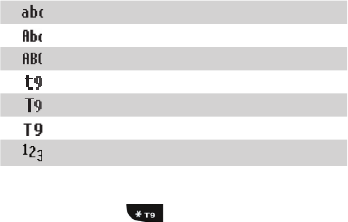
Getting started 25
Multipress text input mode, lowercase
Multipress text input mode, uppercase
Multipress text input mode, caps lock
T9 text input mode, lowercase
T9 text input mode, uppercase
T9 text input mode, caps lock
Numeric input mode
To change the input mode
1.
Press and hold the
key.
2.
On the menu, click the input mode you want.
Use Multipress mode
In Multipress mode, you can enter a character by pressing the numeric key
on which the character appears.
To enter text in Multipress mode
•
To enter the fi rst character on the numeric key, press once. To enter
the second character on the numeric key, press twice and so on.
•
To enter a character that is on the same numeric key, pause after you
enter the fi rst character.
•
To enter punctuation, press the
1
key repeatedly until you see the
punctuation you want.
To change the Multipress time out
You can change the length of time to pause between key presses on the
same numeric key.
1.
On the Home screen, click
Start > Settings
> Accessibility
.
2.
In
Multipress time out
, select the length of the pause between key
presses.

26
Getting started
Use T9 mode
To form a word in T9 mode, press the numeric keys that contain the letters
you want. As you enter letters, T9 analyzes your key presses and attempts to
complete the word. For example, to enter the word “shoe”, press 7, 4, 6, 3.
To enter text in T9 mode
1.
Press and hold the
key.
2.
On the menu, click
T9
.
3.
Do any of the following:
•
Enter letters by pressing the keys on which the letters appear.
Press a key only once for each letter. If there is more than one
choice in the T9 dictionary for your entry, a list of available words
is displayed.
•
Press the
key to enter a space after the word as entered,
or click one of the available words and the space is added
automatically.
•
If you do not see the desired word, click
Add Word?
from the list,
and then enter the word using Multipress.
•
To enter punctuation, press the
1
key and select from a list of
common punctuation marks.
Use Numeric mode
If a text box permits a numeric entry only, such as a phone number, the
input mode automatically defaults to Numeric mode. However, if you need
to enter numbers within a line of text, change to Numeric mode, and then
change back to Multipress or T9 mode to finish entering the text.
To enter numbers in text boxes
1.
Press and hold the
key to change to Numeric mode.
2.
On the keypad, enter the number or numbers you want.
3.
Change back to Multipress or T9 input mode by pressing and holding
the
key, and then fi nish entering your text.

Getting started 27
More text entry tasks
In both Multipress and T9 modes, the first letter of a sentence is by default
capitalized.
To change between uppercase, lowercase and caps lock
•
Press the
key to change between uppercase, lowercase and
caps lock within a text input mode.
To delete characters
•
To backspace and delete a single character in any input mode, press
BACK.
•
To backspace and delete an entire text or numeric fi eld in any input
mode, press and hold BACK.
To enter a space
•
In Multipress or T9 mode, press the
key.
To enter a symbol
1.
Press and hold the
key.
2.
On the menu, click
Symbols
to display the Symbol page.
3.
Select the symbol you want and press ENTER.
To start a new line
In a multi-line text box such as the notes area of a contact or a calendar
appointment, do the following:
•
In any input mode, press ENTER.
To enter the plus sign for international calls
•
In a numeric entry box, press and hold
0
.
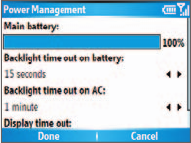
28
Getting started
1.8 Battery Information
Battery performance depends on many factors, including your wireless
service provider’s network configuration, signal strength, the temperature
of the environment in which you operate your phone, the features and/or
settings you select and use, items attached to your phone’s connecting
ports and your voice, data and other program usage patterns.
Battery life estimates (approximations):
•
Talk time: Up to
7.5
hours
•
Standby time: Up to
220
hours
WARNING! To reduce risk of fire or burns:
• Do not attempt to open, disassemble or service the battery pack.
• Do not crush, puncture, short external contacts or dispose of in fire or water.
• Do not expose to temperatures above 60˚C (140˚F).
• Replace only with the battery pack designated for this product.
• Recycle or dispose of used battery as stipulated by local regulation.
The Power Management screen
•
On the Home screen, click
Start >
Settings
>
Power
Management
to
access the Power Management screen.
You can
check the battery power from
the Main battery bar.
•
On Power Management screen, you
can
optimize the power performance
by adjusting the backlight and display
settings.
To manage a low battery
When the low-battery warning appears, do the following:
1.
Immediately save your current data.
2.
Synchronize with your PC to charge the battery.
3.
Turn off your phone.
For information about charging the battery, see the
Quick Start Guide
.

Chapter 2
Using Phone Features
2.1 Using the Phone
2.2 Making a Voice Call
2.3 Receiving a Voice Call
2.4 In-Call Options
2.5 Additional Dialing Information

30 Using Phone Features
2.1 Using the Phone
You can use your phone to make, receive, keep track of voice calls and
send text messages (SMS, Short Message Service) and MMS (Multimedia
Messaging Service) messages. You can also dial a phone number directly
from Contacts and easily copy SIM contacts to Contacts on the phone.
The Phone screen
From the Phone screen, you can open, call or find a contact, and even
save a new number in Contacts. To access the Phone screen, do any of the
following:
•
Press TALK (
).
•
Directly enter the phone number by pressing numeric keys on the
Keypad.
Enter your PIN
Most Subscriber Identity Module (SIM) cards are preset with a personal
identification number (PIN) that is provided by your wireless service
provider.
1.
On the Home screen, click
Start > Settings > Security > Enable SIM
On the Home screen, click Start > Settings > Security > Enable SIM On the Home screen, click
PIN
.
2.
Enter the preset PIN provided by your wireless service provider.
3.
Click
Done
.
Note If your PIN is entered incorrectly three times, the SIM card will be blocked. If
this happens, you can unblock it with the PIN Unblocking Key (PUK) obtained
from your wireless service provider.
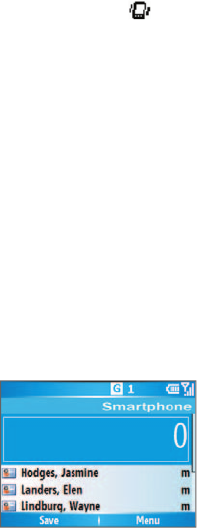
Using Phone Features 31
Set ring tones
You can choose how to be notified for incoming calls, reminders, new
messages, alarms and more.
To set a ring tone for incoming calls
1.
On the Home screen, click
Start > Settings > Sounds
.
2.
In the Ring tone list, select a ring tone.
3.
Click
Done
.
If you select Vibrate, the sound is muted and the phone will vibrate when
you receive a call. The Vibrate icon (
If you select Vibrate, the sound is muted and the phone will vibrate when
you receive a call. The Vibrate icon (
)
appears in the title bar. Selecting
None
in the Ring tone list mutes the phone. For more information about
sounds, see “Choose how to be notified about events or actions” in
Chapter 4.
Note To adjust the earpiece volume during a call, use the JOG BAR on the phone
side panel. Adjusting the volume at any other time can affect the ring,
notification and MP3 sound levels.
2.2 Making a Voice Call
With your phone, you can make calls from the Home screen, the Phone
screen, from Contacts, Speed Dial, Call History or SIM Contacts (contacts
stored on your SIM card).
Make a call from the Phone screen
•
On the Home screen, access the Phone screen by pressing TALK or
pressing numeric keys on the keypad.
Phone Screen
32 Using Phone Features
Tips
• While entering the phone number, press the BACK button if you need to
backspace
• You will notice that when you press a numeric key on the Keypad, a list of
names and numbers is displayed as your phone searches Contacts, Call
History, Speed Dial and your SIM card to find a matching name or number.
For example, when you press a number such as 5, names that begin with J, K
and L will be displayed as well as phone numbers that start with 5. The next
number you press continues to narrow the search. When you see the name
of the person you want to call, select it and press TALK.
Make a call from Contacts
1.
On the Home screen, click
Start > Contacts
.
2.
Select the desired contact and press TALK.
You can also select the desired contact in the contact list and press the
ENTER button twice (once to view the contact details, and once to dial the
associated number).
To specify the number to dial
By default, the mobile phone number (m) of a contact is dialed when you
make a call from Contacts; however, you can choose to dial a different
phone number.
1.
On the Home screen, click
Start >
Contacts
.
2.
Select the contact.
3.
Press NAVIGATION left or right. The letter representing the number
changes to m (mobile), w (work) or h (home).
You can also select a contact in the contact list and press ENTER to view
details and different numbers associated with the contact. Select a number
and press TALK or press ENTER to dial the number.
•
You may also access the contact list by clicking
Contacts
on the
Home Screen.
•
To view or edit information associated with the selected contact, click
Menu
>
Edit
.
•
To save a contact on your SIM card, click
Menu
>
Save to SIM
.
Using Phone Features 33
Make a call from Call History
1.
On the Home screen, click
Start
>
Call History
.
2.
Select a name or number and press TALK.
In the Call History screen, press ENTER to view details, such as the dialed,
missed, received call, call duration, date and time. Pressing ENTER again
dials the associated number.
To customize calls
You can select various options on the Call History screen to customize and
filter the calls made, received or missed.
•
To fi nd a name or number in Contacts, click
Menu
>
Find Contact
.
•
To send a text message, click
Menu
>
Send Text Message
.
•
To send an e-mail, click
Menu
>
E-mail
.
•
To fi nd the duration of a call, click
Menu
>
View Timers
.
•
To remove a call or number from Call History, click
Menu
>
Delete
.
•
To remove the list of calls or numbers from
Call History
, click
Menu
>
Delete List
.
•
To save a name or number in Contacts, click
Menu
>
Save to
Contacts
.
•
To categorize the call or number into various call types, click
Menu
>
Filter
.
Note You can also save a number in Contacts by clicking Save on the Call History
screen.
Make a call from Speed Dial
You can make calls using Speed Dial. To learn how to use Speed Dial, see
“Using Speed Dial” in Chapter 8.
Make a call from SIM Manager
1.
Click
Start
> Accessories > SIM Manager.
Wait for the contents of
your SIM card to load.
2.
Choose the contact you want to call and click
Menu
>
Dial.
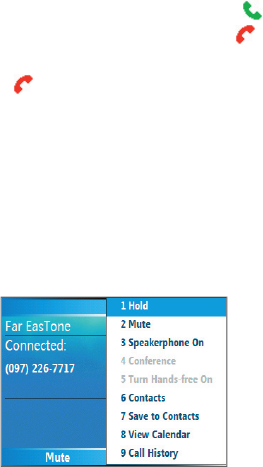
34 Using Phone Features
2.3 Receiving a Voice Call
When you receive a phone call, you have the option to answer it or ignore it.
To answer or ignore an incoming call
•
To answer the call, click
Answer
or press TALK (
).
•
To ignore the call, click
Ignore
or press END (
).
To end a call
•
Press END (
).
2.4 In-Call Options
Your phone provides various options for managing multiple calls at the
same time. You are notified when you have another incoming call, and you
have the choice of ignoring or accepting the call. If you are already on a call
and accept the new call, you can choose to switch between the two callers
or set up a conference call between all three parties.
In-Call Options
Note Call Waiting should be enabled and supported for you to be notified of
an incoming call when you are using the phone. To enable Call Waiting,
click Start > Settings > Phone > Call Waiting > Provide call waiting
notifications.

Using Phone Features 35
To answer another call
1.
Click
Answer
to take the second call and put the fi rst call on hold.
2.
To end the second call and return to the fi rst call, press
END.
To switch between calls
•
To switch between two calls, click
Swap
.
To set up a conference call
1.
Either put a call on hold and dial a second number, or answer a
second incoming call during a call.
2.
Click
Menu >
Conference
.
Notes
• If the conference connection is successful, the word “Conference” appears at
the top of the screen.
• To add additional persons to your conference call, click Menu > Hold, enter
the phone number, and then click Resume to return to the call.
• Not all service providers support conference call. Contact your service
provider for details.
To turn the Speakerphone on and off
The built-in Speakerphone allows you to talk hands-free or lets other people
listen to the conversation.
•
During a call, click
Menu
>
Speakerphone On
. The
icon appears
at the top of the screen.
•
To turn off the Speakerphone during the call, click
Menu >
Speakerphone Off
. Alternatively, the speakerphone can be toggled
on and off by pressing and holding the TALK key during the call.
WARNING! To avoid damage to your hearing, do not hold your phone against
your ear when the Speakerphone is turned on.
To mute a call
•
During a call, click
Menu
>
Mute
.
You can turn off the microphone during a call, so that you can hear the
caller but the caller cannot hear you. When the microphone is turned off,
the
icon appears on the screen. Click
Menu >
Unmute
to turn on the
microphone again.

36 Using Phone Features
2.5 Additional Dialing Information
Make an emergency call
•
Enter the appropriate emergency number for your locale and press
TALK.
Tip Additional emergency numbers may be included in your SIM card. Contact
your service provider for details.
Make an international call
1.
Press and hold
on the phone keypad until the
sign appears. The
replaces the international prefi x of the country that you are calling.
2.
Enter the full phone number and press TALK. The full phone number
includes country code, area code (without the leading zero, if any)
and phone number.
Insert a pause in a dialing sequence
Some international calls require a pause in the dialing sequence in order for
the call to process successfully.
1.
On the Home screen, click
Start
>
Contacts
.
2.
Select the contact entry that contains the phone number into which
you want to insert a pause, and then press ENTER to open the contact
card.
3.
Click
Menu >
Edit
.
4.
Position the cursor on the phone number where you want to insert a
pause.
5.
Click
Menu
Click MenuClick
>
Insert Pause
.
The letter “p” will appear in the number to indicate where the pause
will occur in the dialing sequence.
6.
Click
Done
.
Using Phone Features 37
Insert a longer pause in a dialing sequence
Some phone numbers may require a longer pause than the default pause in
the dialing sequence. In these cases, you can pause as long as you want and
manually continue the dialing sequence.
Note This feature is not available for contacts stored on the SIM card.
1.
On the Home screen, click
Start
>
Contacts
.
2.
Select the contact entry that contains the phone number into which
you want to insert a longer pause, and then press ENTER to open the
contact card.
3.
Click
Menu
>
Edit
.
4.
Position the cursor on the phone number where you want to insert a
longer pause.
5.
Click
Menu
>
Insert Wait
.
The letter “w” will appear in the number to indicate where the longer
pause (wait) will occur in the dialing sequence.
6.
Click
Done
.
Note When you call a number that contains a longer pause, you must press TALK
to continue dialing.
SIM Tool Kit (STK)
A SIM card must be inserted in your device in order to use this feature,
which allows you to access a range of information services provided by your
service provider.
1.
On the Home screen, click
Start
>
SIM Tool Kit (STK)
. A list of
provided services appears.
2.
To access a service, click the item in the list.
38 Using Phone Features

Chapter 3
Synchronizing Information and
Setting Up E-mail Security
3.1 About ActiveSync
3.2 Setting Up ActiveSync
3.3 Synchronizing Information
3.4 Synchronizing via Bluetooth
3.5 Synchronizing Music,
Video and Pictures
3.6 Setting Up E-mail Security
40 Synchronizing Information and Setting Up E-mail Security
3.1 About ActiveSync
ActiveSync synchronizes information on your phone with information on
your PC such as Outlook content. ActiveSync can also synchronize over
a wireless or cellular network with Exchange Server if your company or
service provider is running Exchange Server with Exchange ActiveSync.
Specifically, you can use ActiveSync to:
•
Synchronize information such as Outlook e-mail, contacts, calendar
or tasks information on your phone with your PC, as well as pictures,
video and music.
•
Synchronize Outlook e-mail, contacts, calendar appointments and
tasks on your phone directly with Exchange Server so that you can
stay up to date even when your PC is turned off .
•
Copy fi les between your phone and your PC.
•
Select which types of information are synchronized and specify how
much information is synchronized. For example, you can choose how
many weeks of past calendar appointments to synchronize.
•
Add and remove programs on your phone. For details, see Chapter 4,
“Adding and Removing Programs.”
3.2 Setting Up ActiveSync
To install and set up ActiveSync on the computer
1.
Install ActiveSync on your PC, as described on the Windows Mobile™
Getting Started Disc.
2.
After Setup completes, the Synchronization Setup Wizard
automatically starts when you connect your phone to the PC. The
wizard will guide you to create a synchronization relationship
between your phone and computer. Click
Next
.
3.
Do not select the
Synchronize directly with a server running
Microsoft Exchange Server
check box if you will synchronize your
phone with a computer. Just click
Next
, then skip to step 8.
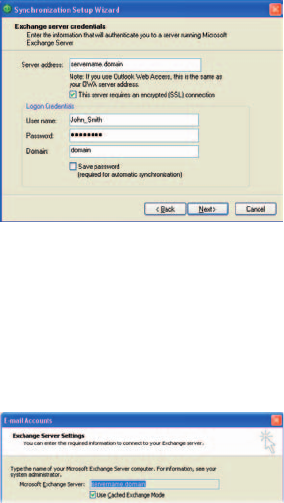
Synchronizing Information and Setting Up E-mail Security 41
4.
If you will synchronize your phone with Exchange Server, select the
Synchronize directly with a server running Microsoft Exchange
Server
check box, then click
Next
.
5.
On the Exchange server credentials screen, enter the Exchange server
address, your user name and password and the domain name.
If
you do not know what the Exchange server address and domain
name are, you can check with your network administrator, or you can
check them in your computer by doing the following:
a.
In Outlook, click
Tools > E-mail Accounts
.
b.
Select
View or change existing e-mail accounts
.
c.
Double-click
Microsoft Exchange Server
.
d.
On the Exchange Server Settings screen, you will see the Exchange
Server name.
e.
To check the domain name, click
Start > Settings > Control
Panel
, then double-click
System
.
f.
In the System Properties dialog box, click the
Computer Name
tab. You will then see the domain name.
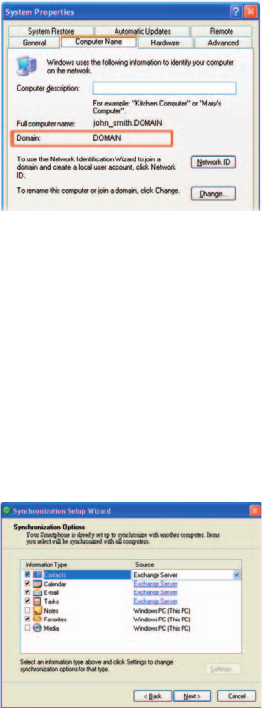
42 Synchronizing Information and Setting Up E-mail Security
6.
On your phone, you also need to enter the Exchange server settings.
For information about this, see “Synchronizing directly with Exchange
Server.”
7.
On the Synchronization Setup Wizard, click
Next
.
8.
Select the information types to synchronize between your phone and
computer.
If
you will synchronize your phone with both your computer and
Exchange Server, do the following:
•
For the Contacts, Calendar, E-mail and Tasks items, choose whether
to synchronize them with the computer or with the Exchange
Server. These items cannot be synchronized to both.
•
Select the check boxes of the other information types if you want
to synchronize them with your computer.
Synchronizing Information and Setting Up E-mail Security 43
9.
Click
Next
.
10.
Click
Finish
.
When you finish the wizard, ActiveSync synchronizes your phone
automatically. Once synchronization completes, you can disconnect your
phone from your PC.
3.3 Synchronizing Information
When you connect your phone to the PC, ActiveSync will immediately
synchronize. While the phone is connected, ActiveSync synchronizes every
time you make a change on either the PC or the phone.
To manually start and stop synchronization
1.
Connect your phone.
•
To synchronize local information on the PC, such as Outlook
information or media files, connect your phone to the PC using
Bluetooth or a cable.
•
If you are synchronizing directly with Exchange Server, you can
use the connection to the PC to access the network, or you can
synchronize over a cellular network without connecting to the PC.
2.
In ActiveSync, click
Sync
. To end synchronization before it completes,
click
Stop
.
Note ActiveSync 4.x utilizes a network type of connection with Windows Mobile
powered devices, since this allows faster data transfer than a serial USB
connection. When the PC is connected to the Internet or a local network,
in some cases, the PC may disconnect the ActiveSync connection with
your device in favor of the Internet or network connection. If this happens,
click Start > Settings > Connections > USB to PC, then clear the Enable
advanced network functionality check box. This makes ActiveSync utilize a
serial USB connection with your device.

44 Synchronizing Information and Setting Up E-mail Security
Synchronize Outlook information with the computer
If you have set up a synchronization relationship between your phone and
the PC, synchronization keeps Outlook information up-to-date on both of
them.
You can also set up your phone to synchronize with more than one PC
or with a combination of one or more PCs and Exchange Server. When
synchronizing with multiple computers, the items you synchronize will
appear on all of the computers with which they are synchronized. For
example, if you have set up synchronization with two PCs (PC1 and PC2),
which have different items, and you synchronize Contacts and Calendar on
the phone with both computers, the result is as follows:
Location New state
PC1
All Outlook contacts and calendar appointments that were on
PC2 are now also on PC1.
PC2
All Outlook contacts and calendar appointments that were on
PC1 are now also on PC2.
Phone
All Outlook contacts and calendar appointments from both
PC1 and PC2 are on the phone.
Note Outlook e-mail can be synchronized with only one computer.
To change which information is synchronized
ActiveSync synchronizes a limited amount of information by default to save
storage space on your phone. You can change the amount of information
that is synchronized by performing the following steps.
Note Before changing synchronization settings on the phone, disconnect it from
your PC.
1.
On the Home screen, click
Start
>
ActiveSync
.
2.
In ActiveSync, click
Menu > Options
.
3.
Do one or more of the following:
•
Select the check box for the items you want to synchronize. If you
cannot select a check box, you might have to clear the check box
for the same information type elsewhere in the list.
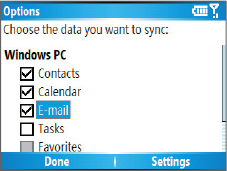
Synchronizing Information and Setting Up E-mail Security 45
•
Clear the check box for any items you want to exclude.
•
To customize synchronization of a computer, select the computer
name then click
Menu
>
Settings
.
•
To customize synchronization of a particular information, select
the information type then click
Settings
.
•
To stop synchronizing with one computer completely, select the
computer name and click
Menu
>
Delete
.
Note Outlook e-mail can be synchronized with only one computer.
Synchronize Outlook information with Exchange Server
You can set up synchronization with Exchange Server on your phone, if
it is available to you through your company or wireless service provider.
However, you should first ask your administrator or check your computer
for the following information and then carry on with the steps: Exchange
Server name, domain name, your user name and password. (For information
about how to check the Exchange server name and domain on your PC, see
“To install and set up ActiveSync on the computer.”)
Note Before changing synchronization settings on the phone, disconnect it from
your PC.
To synchronize directly with Exchange Server
1.
On the Home screen, click
Start
>
ActiveSync
>
Menu
>
Confi gure
Server
. If you have not yet set up synchronization with Exchange
Server, this will say
Add Server Source
.
46 Synchronizing Information and Setting Up E-mail Security
2.
On the Edit Server Settings screen, enter the name of the server
running Exchange Server in the
Server address
box, then click
Next
.
3.
On the User Information screen, enter your user name, password and
domain name.
4.
If you want the phone to save your password so that you will not
need to enter it again when connecting, select the
Save password
check box. Then, click
Next
.
5.
On the Options screen, select the check boxes of the types of
information that you want to synchronize with the Exchange Server.
6.
To customize synchronization of a particular information, select the
type of information then click
Menu
>
Settings
.
Note Settings is not available for Contacts and Tasks.
7.
To change the rules for resolving synchronization confl icts, click
Menu
>
Advanced
on the Options screen.
8.
Click
Finish
.
Note You can also use the Sync Setup Wizard to set up the phone to synchronize
remotely with the Exchange Server. This wizard is started when you connect
your phone to your PC after installing ActiveSync on the PC.
Schedule synchronization with Exchange Server
You can schedule information to be synchronized automatically between
your phone and the Exchange Server or schedule synchronization at regular
time intervals. Choose between these two methods, depending on your
e-mail volume and which method you think is more cost-effective.
To receive e-mails and synchronize other information instantly
The
Direct Push
technology (Push E-Mail feature) enables you to receive
new e-mails on your phone as soon as they arrive in your Inbox on the
Exchange Server. With this feature, items such as contacts, calendar and
tasks are also immediately updated onto your phone when these items
have been changed or new entries have been added on the Exchange
Server. To make Direct Push work, you need to set up a GPRS connection on
your phone.
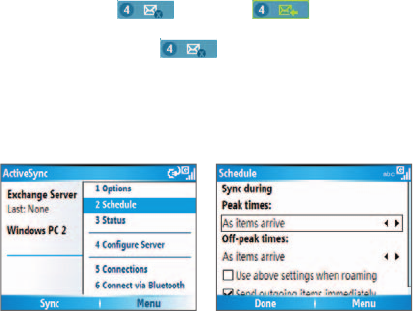
Synchronizing Information and Setting Up E-mail Security 47
The Direct Push feature works for your phone, if your private network such
as your corporate network is using Microsoft Exchange Server Service Pack
2 (SP2) with Exchange ActiveSync and after your first full synchronization
with the Exchange Server.
Using Comm Manager
1.
Click
Start
>
Comm Manager
.
2.
In the Comm Manager screen, click the
Microsoft Direct Push
button. The button
In the Comm Manager screen, click the
will turn to
,
this indicates that
you will receive e-mails as they arrive.
When the button is in the
you will receive e-mails as they arrive.
state, you need to manually
retrieve your e-mails.
Using ActiveSync
1.
In ActiveSync on your phone, click
Menu > Schedule
.
2.
Select
As items arrive
in the
Peak times
and
Off -peak times
boxes.
To schedule synchronization at regular time intervals
You can set how often to synchronize during
Peak times
(which usually
refer to your working hours) when e-mail volume is high, as well as
Off-
times
when e-mail volume is low.
1.
In ActiveSync on your phone, click
Menu > Schedule
.
2.
On the Schedule screen, select a shorter time interval in the
Peak
times
box for you to be able to receive e-mails more frequently.
3.
Select a longer interval in the
Off -peak times
box.
Tip To set the days and hours that make up your peak and off-peak times, click
Menu > Peak Times on the Schedule screen.
48 Synchronizing Information and Setting Up E-mail Security
3.4 Synchronizing via Bluetooth
You can connect your phone to the PC to synchronize using the local
wireless technology, Bluetooth.
To synchronize with a PC via Bluetooth
1.
Follow the instructions in ActiveSync Help on the PC for confi guring
Bluetooth on your PC to support ActiveSync.
2.
On the Home screen, click
Start
>
ActiveSync
.
3.
Click
Menu
>
Connect via Bluetooth
. Ensure that the phone and the
PC are within close range.
4.
If this is the fi rst time you have connected to this PC via Bluetooth,
you must complete the Bluetooth wizard on the phone and set up a
Bluetooth partnership with the PC before synchronizing.
5.
Click
Sync
.
6.
When fi nished, click
Menu
>
Disconnect Bluetooth
.
Notes
• To preserve battery power, turn off Bluetooth when not in use.
• To connect and synchronize your phone with a computer via Bluetooth,
your computer must have a Bluetooth adapter or dongle.
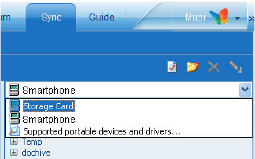
Synchronizing Information and Setting Up E-mail Security 49
3.5 Synchronizing Music, Video and Pictures
If you want to take your music or other digital media with you, ActiveSync
works with Windows Media Player
to synchronize music, video and pictures
with your phone.
Other than selecting the media information type in ActiveSync to be
synchronized, all media synchronization settings must be set in Windows
Media Player. Before media can be synchronized, you must do the following:
•
Install Windows Media Player Version 10 or later on the PC.
•
Connect your phone to the PC with a USB cable. If the phone is
currently connected using Bluetooth, you must end that connection
before media can be synchronized.
•
Insert a 32MB or larger storage card into your phone.
•
Set up a sync partnership between the storage card and Windows
Media Player.
Change Media synchronization settings
Once you select the Media information type in ActiveSync to be
synchronized, any of your favorite music, video and picture files in Windows
Media Player playlists can be synchronized by ActiveSync. All you have to do
is set up synchronization in Windows Media Player for those media files.
To set up a sync relationship with a storage card
1.
On the PC, open Windows
Media Player.
2.
Click the
Sync
tab.
3.
Select the storage card.
4.
Click
Set up Sync
.
5.
Choose whether to
synchronize automatically
or manually.
For information about using Windows Media Player on the phone, see
“Using Windows Media Player” in Chapter 7.
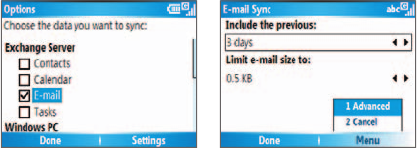
50 Synchronizing Information and Setting Up E-mail Security
3.6 Setting Up E-mail Security
Windows Mobile on your phone protects your Outlook e-mails through
Secure/Multipurpose Internet Mail Extension (S/MIME), which allows you to
digitally sign your messages as well as encrypt them.
Using authorization keys and certificates, S/MIME allows you to digitally sign
your e-mail messages to prove your identity to the recipients. Authorization
keys are also used when encrypting messages to improve privacy and
prevent undue tampering or hacking of your messages. You can encrypt
a message with or without a certificate. However, to read an encrypted
message, you need a valid certificate for decrypting e-mail messages.
Note S/MIME encryption and digital signatures for Windows Mobile-based devices
are available only with Exchange Server 2003 Service Pack 2 or a later version
that supports S/MIME. If you aren’t using one of these products or have not
yet synchronized, these options are unavailable.
Digitally sign and encrypt all messages
ActiveSync allows you to set up S/MIME e-mail encryption and signing. You
will have to obtain a valid certificate for signing or encrypting e-mail before
you will be able to sign or encrypt mail successfully.
1.
On the Home screen, click
Start > ActiveSync
.
2.
Click
Menu > Options
.
3.
Select the
E-mail
information type and click
Settings
. On the E-mail
Sync screen, click
Menu > Advanced
.
Synchronizing Information and Setting Up E-mail Security 51
4.
Do one or both of the following:
•
To sign all your outgoing e-mail messages so that recipients can
be certain that the messages were sent by you and have not been
altered in any way, select
Sign messages
.
•
To encrypt all your outgoing e-mail messages so that the contents
of your messages are protected from being viewed by anyone
other then the intended recipients, select
Encrypt messages
.
5.
Click
Menu > Choose Certifi cate
to select a certifi cate for signing or
encrypting outgoing e-mail messages.
You
can select certifi cates to sign or encrypt e-mail messages
individually if you do not choose to sign or encrypt all outgoing
e-mails. For information about signing and encrypting individual
messages, see “Individually sign and encrypt a message” in Chapter 6.
52 Synchronizing Information and Setting Up E-mail Security

Chapter 4
Managing Your Phone
4.1 Personalizing your Phone
4.2 Adding and Removing Programs
4.3 Using Task Manager and Managing Memory
4.4 Managing and Backing Up Files
4.5 Protecting your Phone
4.6 Restarting your Phone
4.7 Resetting your Phone
54 Managing Your Phone
4.1 Personalizing your Phone
Set up the Home screen
The Home screen is your starting place for most tasks. You can gain access
to all features and programs from the Home screen.
The top of the Home screen displays icons for the programs that you have
most recently used. The center of the Home screen can display your next
appointment, the number of new messages (voice mail, text, e-mail or
MMS) that you have received and other important information. When you
click an icon or item on the Home Screen, the associated program opens.
To customize the Home screen
1.
On the Home screen, click
Start
>
Settings
>
Home Screen
.
2.
In
Home screen layout
,
Color scheme
,
Background
image
and
Time out
, select the options you want, and then click
Done
.
To set a picture as the background
1.
On the Home screen, click
Start
>
Pictures & Videos
.
2.
Select the picture you want to set as the background.
Click
View
or press ENTER for a larger view of the image
3.
Click
Menu
>
Use as Home Screen
.
4.
Use NAVIGATION to select the portion of the picture you want to use,
and then click
Next
.
5.
In
Adjust the transparency
, select a higher percentage for a more
transparent picture or a lower percentage for a more opaque picture.
6.
Click
Finish
.
Set date , time , language and other regional options
Your phone should already be set up with the regional settings that are
appropriate for your locale.
To change regional settings
You can specify the language, locale, date and time style, as well as number
and currency formatting options.
Managing Your Phone 55
1.
On the Home screen, click
Start
>
Settings
>
Regional Settings
.
2.
In
Language
, select your preferred language.
3.
In
Locale
, select the locale for the language you selected. The Locale
option automatically changes the format of the remaining options
(such as date, time and currency) according to the locale you specify.
4.
Click
Done
.
Note
You must turn your phone off and on again for the changes to take effect.
To set the date and time
1.
On the Home screen, click
Start
>
Settings
>
Clock & Alarm >
Date
and Time
.
2.
In
Time zone
, select your time zone.
3.
In
Date
, edit the month, day or year.
4.
In
Time
, edit the hour, minute and second.
5.
Click
Done
.
Choose how to be notified about events or actions
A profile is a group of settings that determine how your phone will alert
you to incoming calls, events such as e-mail receipt notifications, alarms or
system events. A number of different preset combinations of these settings
are included with your phone. Each profile appears with a descriptive name.
To change the current profi le
1.
On the Home screen, click
Profi le [Type]
. Example:
Profi le Normal
.
2.
Click a new profi le and click
Done
.
Tip To quickly change the profile, briefly press POWER to display the Quick List
and click a profile.
To edit a profi le
1.
On the Home screen, click
Profi le [Type]
. Example:
Profi le Normal
.
2.
Select the profi le to edit.
3.
Click
Menu
>
Edit
.
56 Managing Your Phone
4.
Do one of the following:
•
Modify the settings and click
Done
.
•
To cancel without saving changes, click
Cancel
.
Tip To revert to the default profile settings, click Menu > Reset to default.
To specify the sound for an event
1.
On the Home screen, click
Start
>
Settings
>
Sounds
.
2.
For the desired event, select a sound. Select
None
if you do not want
to hear a sound.
3.
Click
Done
.
Note For ring tones, you can use sounds in either .wav, .mid, .wma or .mp3 file
format. For notifications or reminders, you can use .wav or .mid files.
Tip When you select a sound, the sound plays. To hear it again, select Menu >
Play.
To set sound for the keypad
1.
On the Home screen, click
Start
>
Settings
>
Sounds
.
2.
In
Keypad control
, select a sound. Select
None
if you do not want to
hear any sound while pressing a key.
3.
Click
Done
.
To copy a sound to your phone
After a sound file is located on your phone, you can use it for a ring tone,
notification or reminder. Sound files in either .wav, .mid, .wma or .MP3
formats can be used.
1.
Connect the phone to your PC using a USB connection.
2.
On your PC, copy the sound fi le you want.
3.
In ActiveSync on your PC, click
Explore
and double-click
My
Windows Mobile-Based Device
.
4.
Do one of the following:
•
To save the sound file on your phone, double-click
Application
Data
, double-click
Sounds
and paste the file into that folder.
•
To save the sound file on your storage card, double-click
Storage
Card
and paste the file into the folder you want.
Managing Your Phone 57
To set an alarm
1.
On the Home screen, click
Start
>
Settings
>
Clock & Alarm
>
Alarm
.
2.
In
Alarm
, choose one of the following:
•
Off
to turn the alarm off.
Off to turn the alarm off. Off
•
On
to turn the alarm on.
3.
In
Alarm time
, enter the time for the alarm to go off .
4.
Click
Done
.
Set personal information
Entering and displaying owner information
are best practices; they allow
someone to return the phone to you in case it is lost.
To enter owner information
1.
On the Home screen, click
Start
>
Settings
>
Owner Information
.
2.
Complete the following:
•
In
Name
, enter your name.
•
In
Telephone number
, enter a number where you can be reached.
•
In
E-mail address
, enter your e-mail address.
•
In
Notes
, enter any other information you want to include.
3.
Click
Done
.
Set performance and maintenance options
To change accessibility settings
1.
On the Home screen, click
Start
>
Settings
>
Accessibility
.
2.
Select your preference for the following:
•
System
font size
to set the size of the font that is displayed on the
screen.
•
Multipress time out
to set the length of time between keypresses
when entering text in Multipress mode.
•
Confirmation time out
to set the delay before an unconfirmed
action times out.
58 Managing Your Phone
•
In-call alert volume
to set the volume for incoming call or
receiving new message alerts while you are in a call.
3.
Click
Done
.
To change power management settings
You can use Power Management to check the battery and configure
settings that prolong battery life.
1.
On the Home screen, click
Start
>
Settings >
Power
Management
.
2.
Adjust the following:
•
In
Backlight time out on battery
, select the amount of time for
the phone to be idle before the backlight turns off.
•
In
Backlight time out on AC
, select the amount of time for the
phone to be idle before the backlight turns off when using AC
power.
•
In
Display time out
, select the time limit for the phone to be idle
before the screen turns off.
•
In
Light Sensor Enable
, turn it on to see the buttons on the
keypad more easier in the dark.
3.
Click
Done
Click DoneClick
.
Tip Main battery indicates the amount of battery life remaining.
To fi nd the operating system version number
•
On the Home screen, click
Start
>
Settings
>
About
.
The operating system version number installed on your phone along
with the manufacturer copyright information will be listed on the
screen.
To fi nd the phone specifi cation
•
On the Home screen, click
Start
>
Settings
>
System Information
.
The System Information screen displays the details about the phone
specifi cation, such as processor, speed, memory, display, model name
and so on.
Managing Your Phone 59
To turn on and off error reporting
1.
On the Home screen, click
Start
>
Settings
>
Error Reporting
.
2.
Do one of the following:
• Select
Enable
to turn on error reporting.
•
Select
Disable
to turn off error reporting.
3.
Click
Done
.
4.2 Adding and Removing Programs
Before you purchase additional programs for your phone, you should note
the name of your phone, the version of Windows Mobile software running
on it and the type of processor. This information will help you select a
program that is compatible with your phone. For more information, see “To
find the operating system version number” in this chapter.
Programs available for purchase usually include a Setup program
(commonly named “setup.exe”) that you must first install on your PC. You
can then use ActiveSync to add programs to your phone or add a program
directly from the Internet.
To add programs
1.
Download the program to your PC (or insert the CD or disk that
contains the program into your PC). You may see a single *.exe fi le, a
*.zip fi le, a Setup.exe fi le or several versions of fi les for diff erent device
types and processors. Be sure to select a program designed for your
phone and processor type.
2.
Read any installation instructions or documentation that comes with
the program. Many programs provide special installation instructions.
3.
Connect your phone and PC.
4.
Double-click the *.exe fi le.
•
If the executable file is an installation wizard, follow the
instructions on the screen. Once the program has been installed
on your PC, the wizard will automatically transfer the program to
your phone.
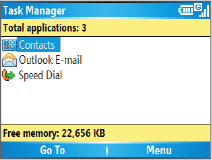
60 Managing Your Phone
•
If an installation wizard does not start, you will see an error
message stating that the program is valid but that it is designed
for a different type of computer. You will need to copy this
program to your phone. If you cannot find any installation
instructions for the program, use ActiveSync to copy the program
file to the Program Files folder on your phone.
To remove a program
Programs that come with the phone cannot be removed.
1.
On the Home screen, click
Start
>
Settings
>
Remove Programs
.
2.
Scroll to the program to remove.
3.
Click
Menu
>
Remove
.
4.3 Using Task Manager and Managing Memory
To see how much memory is available
1.
On the Home screen, click
Start
>
Settings
>
About
.
2.
Scroll down to
Available Memory
.
Use Task Manager
Task Manager allows you to view all the programs currently running on your
phone in the form of a list. From Task Manager, you can switch to, activate
or terminate any currently running program. It also allows you to view the
phone memory status and battery information.
To start Task Manager
•
Click
Start >
Task Manager
.
Task Manager

Managing Your Phone 61
The Task Manager Menu contains the following options.
Option Allows you to
Go To
Switch to the selected program.
Refresh
Refresh the Task Manager screen to reflect a list of currently
running programs.
Stop
Stop the selected program. You can view the free memory
status at the bottom of the screen.
Stop All
Stop all listed programs. Click
OK
to confirm that you want
OK to confirm that you want OK
to end all currently running programs. You can view the free
memory status at the bottom of the screen.
Stop
All But
Selected
Stop all running programs in the list except the one you
selected.
System
Info
View information about power status, memory usage, flash
and phone information.
About
View program name, version and copyright information.
62 Managing Your Phone
4.4 Managing and Backing Up Files
You can back up files to your PC using ActiveSync or copy files to a storage
card that is installed by you on your phone. You can also efficiently manage
your files and folders using File Explorer installed on your phone.
Using Microsoft ActiveSync, you can copy or move information from the
PC to the phone and vice versa. Changes you make to the information on
one computer will not affect the information on the other computer. If you
want to automatically update information on both your phone and PC,
synchronize the information instead. For more information about copying
and synchronizing files, see ActiveSync Help on your PC.
To copy a fi le using ActiveSync
Copying a file results in separate versions of a file on your phone and PC.
Because the files are not synchronized, changes made to one file will not
affect the other.
1.
Connect your phone to your PC.
2.
In ActiveSync, click
Explore
, which opens the Mobile Device folder for
your phone.
3.
In the Mobile Device folder, go to the fi le that you want to copy on
your phone or PC.
4.
Do one of the following:
•
To copy the file to your phone, right-click the file and click
Copy
.
Right-click the desired folder on your phone, and then click
Paste
.
•
To copy the file to your PC, right-click the file and click
Copy
.
Right-click the desired folder on your PC and click
Paste
.
Use File Explorer
File Explorer provides many easy-to-use features for file and folder
management.
To start File Explorer
•
On the Home screen, click
Start > File Explorer
.
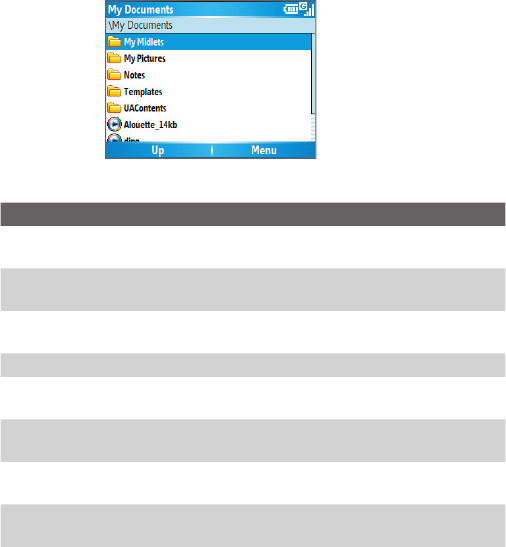
Managing Your Phone 63
File Explorer operates in the following two views:
•
List View
•
Icons View
File Explorer displays the entire file structure in your phone’s memory. The
functions focus primarily on folder management. When initially started, File
Explorer is in List View by default. To switch between views, click
Menu
>
View
>
Icons
or
List
.
File Explorer - List View
The File Explorer menu contains the following options:
Option Allows you to
Send
Lets you send the selected file through one of the
messaging features.
Beam
Lets you send the selected file through Bluetooth or
IrDA.
Edit
Opens a menu where you can choose to cut, copy, paste,
delete or rename a file. You can also create a new folder.
Properties
View information about the selected folder or file.
View
Opens a menu where you can switch between the
Icons
or
List
view.
Sort By
Opens a menu where you can choose to sort the files or
folders by Name, Date, Size or Type.
My Device
Displays the folders and files in the root folder of the
phone.
My Documents
Displays the folders and files in the
My Documents
folder.
64 Managing Your Phone
To send a fi le as an e-mail attachment
1.
In File Explorer, select a fi le.
2.
Click
Menu > Send
.
3.
On the Messaging screen, select
Outlook E-mail
or a custom e-mail
account.
4.
The fi le will automatically be attached to the new message.
Specify the recipient and subject, and then type your message.
5.
Click
Send
.
4.5 Protecting your Phone
There are several levels of security on your phone. You can protect your
phone from unauthorized use by requiring a type of password called a PIN
(personal identification number) in order to make calls. Your first PIN will be
given to you by your wireless service provider. Additionally, you can lock the
keyboard or the entire phone to prevent unauthorized access.
To enable the SIM personal Identifi cation number (PIN)
1.
On the Home screen, click
Start
>
Settings
>
Security
.
2.
Click
Enable SIM PIN
.
3.
Enter your PIN and click
Done
.
Note To cancel without enabling the SIM PIN, press HOME.
To disable the SIM PIN
1.
On the Home screen, click
Start
>
Settings
>
Security
.
2.
Click
Disable SIM PIN
.
3.
Enter your PIN and click
Done
.
To change the SIM PIN
Be sure to make a note of your personal identification number (PIN). When
the SIM PIN is enabled, you must provide this PIN to unlock the phone.
Managing Your Phone 65
1.
Click
Start
>
Settings
>
Security
.
2.
Click
Change SIM PIN
.
3.
In
Old PIN
, enter the current PIN.
4.
Enter and confi rm the new PIN and click
Done
.
To lock the keypad
Locking the keypad turns off keypad functionality. This is a helpful feature
if, for example, the phone is turned on and in your pocket and you want to
prevent accidental keypresses.
•
On the Home screen, press and hold END.
Once the keypad is locked, the left soft key label changes to
Unlock
.
Tip To quickly lock the keypad, press POWER briefly to display the Quick List and
select Key lock.
Note You can still receive calls and make emergency calls when the keypad is
locked.
To unlock the keypad
•
On the Home screen, click
Unlock
and press the * key.
Unlock and press the * key.Unlock
To enable the phone lock
1.
On the Home screen, click
Start
>
Settings
>
Security
>
Device lock
.
2.
Select
Prompt if device unused for
then select the amount of time
for the phone to be inactive before automatically locking.
3.
Select the
Password type
then enter and confi rm your password.
4.
Click
Done
.
Notes
• Alternatively, press POWER briefly to display the Quick List and then select
Device lock to configure the phone lock settings.
• Once you configure the phone lock settings, you can enable the phone lock
from the Quick List directly without configuring the settings again.
To disable the phone lock
•
Click
Unlock
then enter the password you have set to unlock your
Unlock then enter the password you have set to unlock your Unlock
phone.
66 Managing Your Phone
4.6 Restarting your Phone
Occasionally, you may want to restart your phone, for example, when a
program is not performing properly or the phone does not respond to any
keypresses.
To restart the phone
1.
Remove the battery.
2.
Reinsert the battery and turn on your phone.
WARNING! If the phone is restarted while a program is running, unsaved work will
be lost.
4.7 Resetting your Phone
Resetting your phone will remove all the data from its memory which
include contacts, tasks, calendar appointments and more, and restore the
phone back to the factory default settings.
WARNING! All your data will be deleted, it is recommended that you back up your
data first before resetting your phone.
To reset your phone
1.
Click
Start > Accessories > Clear Storage
.
2.
Follow the on-screen instructions to reset the phone.
The phone will restart after it has been reset.

Chapter 5
Getting Connected
5.1 Connecting to the Internet
5.2 Using Internet Explorer Mobile
5.3 Using Internet Sharing
5.4 Using Comm Manager
5.5 Using Bluetooth
68 Getting Connected
5.1 Connecting to the Internet
Your phone’s powerful networking capabilities allow you to access
the Internet or your corporate network at work through wireless and
conventional connections. Specifically, you can configure your phone to
establish a connection via Dial-up, GPRS, Bluetooth, Virtual Private Network
(VPN) or Proxy.
With an active connection on your phone, you can browse the Web,
download e-mails or chat using MSN Messenger. Check with your service
provider to see if a connection has already been set up for you and if over-
the-air configuration is supported.
If you need to manually set up a connection, it is important that you obtain
the following information from your Internet Service Provider (ISP) or the
company whose intranet you are trying to access:
•
ISP server phone number
•
User name
•
Password
•
Access point name (required for GPRS connection)
•
Domain name (required for accessing a corporate network or an
intranet)
Set up a GPRS connection
GPRS is a non-voice value-added service that allows information to be sent
and received across a mobile telephone network. You can use GPRS to
connect to the Internet or to send and receive MMS on your phone. When
you use GPRS, you will be billed per KB (Kilobyte) when sending or receiving
information.
Note Check with your service provider how much it charges for its GPRS service.
If GPRS settings are not preset on your phone, obtain the
Access point
name
from your wireless service provider. Also, check with your wireless
service provider if a user name and password are required.
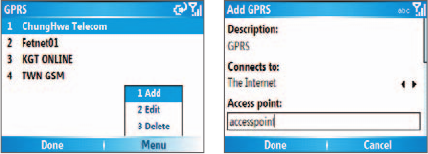
Getting Connected 69
To set up a GPRS connection
1.
On the Home screen, click
Start > Settings > Connections > GPRS
.
2.
Click
Menu >
Add
.
3.
In
Description
, enter a name for the connection.
4.
In
Connects to
, select
The Internet
.
5.
Enter the name of the GPRS
Access point
of your wireless service
provider.
6.
Enter the appropriate information in the remaining fi elds, if required
by your wireless service provider.
7.
Click
Done
.
To
start browsing the Internet, click
Start >
Internet Explorer
.
For
information about setting up and sending MMS, see “Using MMS
Messages” in Chapter 6.
Set up a Dial-up connection
When you use your phone to dial up to your ISP and connect to the Internet
or to your corporate network, you will be billed by the number of minutes
that you use.
To establish a dial-up connection on your phone, you need the same
settings that you normally use when you dial up from your computer. This
includes the ISP server phone number, your user name and password.
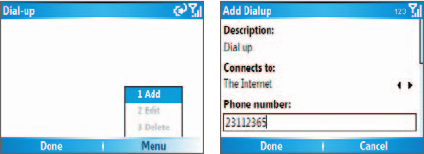
70 Getting Connected
To set up a dial-up connection for browsing the Internet
1.
On the Home screen, click
Start > Settings > Connections > Dial-up
.
2.
Click
Menu >
Add
.
3.
In
Description
, enter a name for the connection.
4.
In
Connects to
, select
The Internet
.
5.
Enter the appropriate information in the remaining fi elds.
6.
Click
Done
. To start browsing the Internet, click
Start >
Internet
Explorer
.
To set up a dial-up connection to your corporate network
1.
On the Home screen, click
Start > Settings > Connections > Dial-up
.
2.
Click
Menu >
Add
.
3.
In
Description
, enter a name for the connection.
4.
In
Connects to
, select
Work
.
5.
Enter the appropriate information in the remaining fi elds.
6.
Click
Done
.
Note You can also add and set up the following connections:
• VPN: A VPN connection is used to access your corporate network by using
an existing Internet connection.
• Proxy: A Proxy connection is used to access the Internet using an existing
connection to your corporate or WAP network.
Getting Connected 71
Advanced options
From the Connections screen, you can access advanced options to specify
the service provider, the number of redial attempts, the amount of idle time
to wait before disconnecting and so on.
1.
On the Home screen, click
Start >
Settings
>
Connections
.
2.
Click
Menu >
Advanced
.
3.
Select a network service provider for each connection type. You can
choose
Automatic
to allow the phone to set a service provider for
each connection by default.
4.
Click
Menu >
Options
.
5.
Choose the appropriate information in the remaining fi elds.
6.
Click
Done
.
Add a URL exception
Some URLs for Web pages on your company intranet may use periods, for
example: intranet.companyname.com. To view these pages in Internet
Explorer Mobile, you must create a URL exception.
1.
On the Home screen, click
Start >
Settings
>
Connections
.
2.
Click
Menu
>
Advanced
.
3.
Click
Menu
>
Work URL Exceptions
.
4.
Click
Menu > Add
.
5.
In
URL Pattern
, enter the URL name.
To add multiple URLs, use a semicolon (;).
6.
Click
Done
.
Note You do not need to create URL exceptions for Internet URLs.
72 Getting Connected
5.2 Using Internet Explorer Mobile
Internet Explorer Mobile is a full-featured Internet browser, optimized for
use on your phone.
To open Internet Explorer
•
On the Home screen, click
Start
>
Internet Explorer
.
To go to a link
1.
While on a Web page, scroll vertically or horizontally to see all
available links.
2.
Click the link.
To go to a Web page
1.
In Internet Explorer, click
Menu
>
Address Bar
.
2.
Enter the address and click
Go
Enter the address and click GoEnter the address and click
.
To change Web page display options
1.
While on a Web page, click
Menu
>
View
.
2.
Select one of the following:
•
One Column
. Arranges the content into one column that is as
wide as the screen. This means that you will rarely have to scroll
horizontally.
•
Default.
Maintains a layout similar to what you see on a desktop
computer, but makes items smaller and arranges the content so
that you can see most of it without having to scroll horizontally.
•
Desktop.
Keeps the same layout and size as on a desktop
computer, which will require both horizontal and vertical scrolling.
To change the size of text on Web pages
•
While on a Web page, click
Menu
>
Zoom
and select the size you
want.
To show or hide pictures on Web pages
•
While on a Web page, click
Menu
>
View >
Show Pictures
.
A check mark next to
Show Pictures
indicates that pictures will be
displayed on Web pages.
Getting Connected 73
To view a page in full-screen mode
•
While on a Web page, click
Menu
>
View >
Full Screen
.
Tip To exit full-screen mode, press either SOFT KEY, and then click Menu > View
> Full Screen to cancel the selection.
To add a Web page to the Favorites list
1.
To go to the page you want to add, click
Menu >
Address Bar
, enter
the address and click
Go
.
2.
Click
Menu
Click MenuClick
>
Add to Favorites
.
3.
Confi rm or change the name and Web page address.
4.
In
Folder
, select a folder for the favorite.
5.
Click
Add
.
Tip A quick way to add favorites to your phone is to synchronize with your PC
using ActiveSync. For more information, see ActiveSync Help on your PC.
To view a favorite
1.
While on a Web page, click
Favorites
.
2.
Select a favorite and click
Go
.
To move a favorite to a folder
1.
Click
Favorites
.
2.
Select the favorite to move.
3.
Click
Menu >
Edit
.
4.
Under
Folder
, scroll to the folder to which you want to move the
favorite.
5.
Click
Done
.
To clear history , cookies or temporary fi les
1.
While on a Web page, click
Menu
>
Tools
>
Options
.
2.
Click
Memory
.
3.
Select the type of memory and click
Clear
to clear.
4.
Click
Yes
to confi rm, and then click
Done
.
74 Getting Connected
To send a link via e-mail
1.
Go to the desired Web page.
2.
Click
Menu
>
Tools
>
Send Link via E-mail
.
3.
Select
Text Messages
or
Outlook E-mail
.
4.
A new message is created with the page address inserted in the
message body.
5.3 Using Internet Sharing
With Internet Sharing, you can use your phone as an external modem for
another device such as a PDA or notebook computer.
Notes • Make sure your phone has a SIM card installed and you have set up a GPRS
or phone dial-up modem connection on your phone. If your phone has
not been set up with a data connection yet, click Menu > Connection
Settings on the Internet Sharing screen. For more information about
setting up a GPRS connection, see "Set up a GPRS connection". For more
information about setting up a phone dial-up connection, see "Set up a
dial-up connection".
•
If you want to use a USB cable connection, you must first install Microsoft
ActiveSync version 4.2 or later on the notebook.
•
Before using Internet Sharing, disable ActiveSync on your computer.
To disable ActiveSync, open ActiveSync then click File > Connection
Settings and clear Allow USB Connections.
Set up the phone as a modem
To set up the phone as a USB modem
1.
On your phone, click
Start > Internet Sharing
.
2.
In the
PC Connection
list, select
USB
.
3.
In the
Network Connection
list, select the name of connection that
your phone uses to connect to the Internet.
4.
Plug in the USB cable between your phone and the computer.
5.
Click
Connect
.
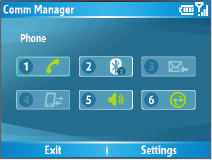
Getting Connected 75
To end the Internet connection
•
On the Internet Sharing screen, click
Disconnect
.
To set up the phone as a Bluetooth modem
You can connect your phone to a computer through Bluetooth and use the
phone as a modem for the computer.
To learn how to set up the phone as a Bluetooth modem, see “Use the
phone as a Bluetooth modem” in this chapter.
5.4 Using Comm Manager
Comm Manager acts like a central switcher that lets you enable or disable
phone features as well as manage your data connections easily.
To open Comm Manager:
Do one of the following:
•
Click
Start
>
Comm Manager
.
•
Briefl y press POWER and click
Comm Manager
from the Quick List.
•
Click the name of your wireless service provider on Home screen.
Simply click the corresponding button to enable or disable a feature.
Comm Manager
76 Getting Connected
1.
Click to toggle between enabling and disabling the phone.
2.
Click to toggle between turning on and off Bluetooth. Click
Settings
> Bluetooth Settings
to confi gure Bluetooth on your phone. See
“Using Bluetooth” for details.
3.
Click to toggle between automatically receiving (as items arrive)
and manually retrieving Outlook e-mails. For more information, see
“To receive e-mails and synchronize other information instantly” in
Chapter 3.
4.
Click to disconnect active data services (e.g. GPRS). You cannot
reconnect data services in Comm Manager.
5.
Click to toggle between turning on the phone’s ringer and setting the
phone to vibration/mute mode.
6.
Click to open ActiveSync so you can synchronize the phone and
computer. For more information about the confi guration settings for
ActiveSync, see Chapter 3.
5.5 Using Bluetooth
Bluetooth is a short-range wireless communications technology. Phones
with Bluetooth capabilities can exchange information over a distance of
about 10 meters without requiring a physical connection. You can even
beam information to a device in a different room, as long as it is within the
Bluetooth signal coverage range.
Bluetooth can be used in the following ways:
•
Beam information, such as fi les, appointments, tasks and contact
cards, between devices that have Bluetooth capabilities.
•
Synchronize information between your phone and computer via
Bluetooth.
•
Use a Bluetooth-enabled headset (or other Bluetooth-enabled
hands-free device such as a car kit) with your phone for hands-free
phone conversations. A Bluetooth stereo headset can also be used for
listening to music.
Getting Connected 77
•
Use a Bluetooth service. Once you connect your phone to another
device or computer using Bluetooth, you can locate and use any of
the services available on that device.
•
Use your phone as a Bluetooth modem for a computer.
Bluetooth modes
Bluetooth on your phone operates in three different modes:
1.
On
. Bluetooth is turned on. Your phone can detect other Bluetooth-
enabled devices, but not vice versa.
2.
Off
. Bluetooth is turned off . In this mode, you can neither send nor
receive information using Bluetooth. You might want to turn off the
radio at times to conserve battery power or in situations where radio
use is prohibited, such as onboard an aircraft and in hospitals.
3.
Visible
. Bluetooth is turned on and all other Bluetooth-enabled
devices within a range of 10 meters can detect your phone.
Note By default, Bluetooth is turned off. If you turn it on, and then turn off your
phone, Bluetooth also turns off. When you turn on your phone again,
Bluetooth automatically turns on.
To turn on or off Bluetooth on your phone
You can enable Bluetooth by clicking the On/Off switch in Comm Manager.
You can also do the following:
1.
On the Home screen, click
Start >
Settings >
Connections
>
Bluetooth
.
2.
In
Bluetooth
, select
On
.
3.
Click
Done
.
To turn off Bluetooth capabilities on your phone, in
Bluetooth
, selec
t Off
.
To make your phone visible
1.
On the Home screen, click
Start > Settings > Connections >
Bluetooth
.
2.
In
Bluetooth
, select
Visible
.
78 Getting Connected
3.
Enter a Bluetooth phone name for your phone. This will be the phone
name that will be shown on another Bluetooth-enabled device when
it searches and detects your phone.
4.
Click
Done
.
Note Selecting the Visible option on the Bluetooth screen also turns on Bluetooth.
Bluetooth partnerships
A Bluetooth partnership is a relationship that you create between your
phone and another Bluetooth-enabled device in order to exchange
information in a secure manner.
Creating a partnership between two devices involves entering the same
personal identification number (PIN) on both devices, and this is a one-
time process. Once a partnership is created, the devices can recognize
the partnership and exchange information without entering a PIN again.
Make sure the two devices are within a range of 10 meters and Bluetooth is
turned on and in visible mode.
To create a Bluetooth partnership
1.
On the Home screen, click
Start >
On the Home screen, click Start >On the Home screen, click
Settings
> Connection
s
>
Bluetooth
.
2.
Click
Menu
>
Devices
.
3.
Click
Menu >
New
to search for a new device.
Your phone searches for other Bluetooth-enabled devices and lists
them.
4.
Select the desired device name in the list.
5.
Click
Next
.
6.
Enter a passcode (1 up to 16 characters) to establish a secure
connection, then click
Next
.
7.
Wait for the paired device to accept the partnership:
•
If you are creating a Bluetooth partnership between your phone
and another Bluetooth-enabled Pocket PC or phone, the receiving
party needs to enter the same passcode that you specified.
Getting Connected 79
•
If you are creating a Bluetooth partnership between your phone
and computer, a balloon message will appear at the bottom-right
of the computer screen, prompting your computer to accept the
partnership. Click the message then enter the passcode.
8.
On your phone, a message will appear, indicating that your phone has
connected with the paired device. Click
OK
.
9.
The name of the paired device is then displayed. You may edit and
enter a new name for that device, then click
Next
.
10.
Select the check boxes of services that you want to use from the
paired device. Click
Done
.
To accept a Bluetooth partnership
1.
Ensure that Bluetooth is turned on and in visible mode.
2.
Click
Yes
when prompted to establish a partnership with the other
device.
3.
Enter a passcode (the same passcode that is entered on the device
requesting the partnership) to establish a secure connection.
The passcode must be between 1 and 16 characters.
4.
Click
Next
.
5.
A message will appear, indicating that your phone has connected
with the paired device. Click
OK
.
6.
The name of the paired device is then displayed. You may edit and
enter a new name for that device, then click
Next
.
7.
Select the check boxes of services that you want to use from the
paired device.
8.
Click
Done
.
You can now exchange information with the other device.
To change the display name of a Bluetooth device
1.
On the Home screen, click
Start
On the Home screen, click StartOn the Home screen, click
>
Settings >
Connections
>
Bluetooth
.
2.
Click
Menu
>
Devices
.
3.
Select a detected Bluetooth device.
80 Getting Connected
4.
Click
Menu >
Edit
.
5.
Enter a new display name for the Bluetooth device, then click
Next
.
6.
Click
Done
.
To delete a Bluetooth partnership
1.
On the Home screen, click
Start >
Settings
>
Connections
>
Bluetooth
.
2.
Click
Menu > Devices
.
3.
Select a Bluetooth device.
4.
Click
Menu
>
Delete
.
5.
Click
Done
Click DoneClick
.
Connect a Bluetooth hands-free or stereo headset
For hands-free phone conversations, you can use a Bluetooth hands-free
headset such as a car kit with your phone.
Your phone also supports
A2DP (Advanced Audio Distribution Profile)
which is for stereo audio over Bluetooth. This means that you can use
a Bluetooth stereo headset with your phone for hands-free phone
conversations as well as for listening to stereo music. Make sure that your
stereo headset also supports A2DP.
Just like when connecting to any Bluetooth device, you also need to enter
a passcode when connecting to a Bluetooth hands-free or stereo headset.
The passcode is fixed and cannot be changed on a Bluetooth headset.
Before you connect it with your phone, check for the proper passcode in the
manufacturer’s documentation.
To connect a Bluetooth hands-free or stereo headset
1.
Make sure that both your phone and the Bluetooth headset are
turned on and within close range, and that the headset is visible.
Refer to the manufacturer’s documentation to fi nd out how to set the
headset in visible mode.
2.
On the Home screen, click
Start > Settings > Connections
.
3.
Click
Bluetooth > Menu > Devices
.